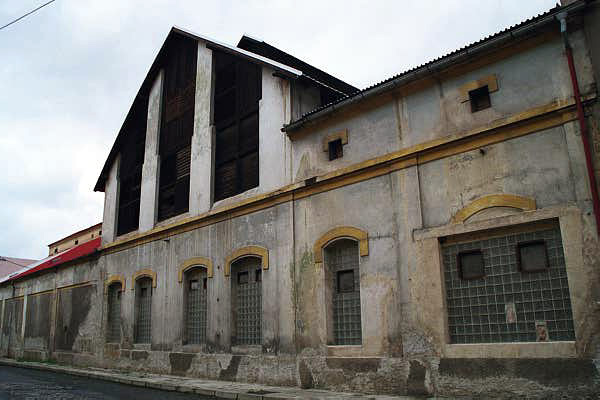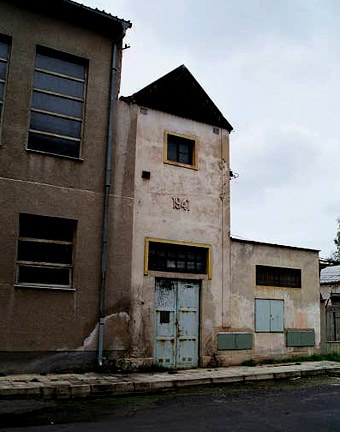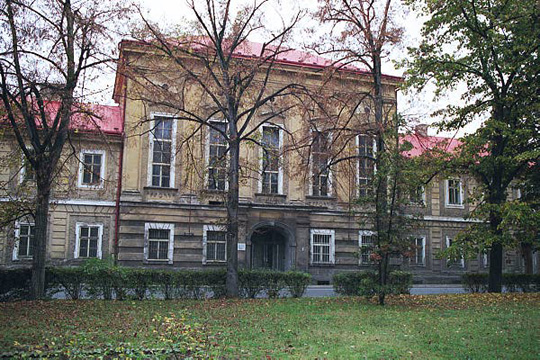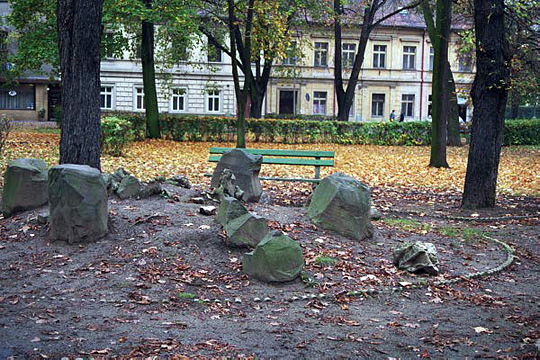Historic buildings
in Terezin

Old Brewery which was
converted into disinfection station
The photograph above shows the old brewery
in Theresienstadt which was converted into a disinfection station
to delouse the clothing of the prisoners in the ghetto.
Although typhus was virtually unknown
in America during World War II, it was an ever present danger
in eastern Europe. During the First World War, epidemics were
rampant and millions of civilians and soldiers died of typhus
on the eastern front in Poland. The Nazis had a systemic plan
to kill all the Jews in Europe, but they didn't want to just
let nature take its course because of the danger of typhus spreading
to the German troops and civilians. For this reason, they tried
to control the lice that causes typhus by disinfecting the clothing
in the camps. To kill the lice they used hot steam or Zyklon
B in disinfection chambers. Zyklon B is the same poison gas which
was used by the Nazis to kill the Jews in the gas chambers in
the death camps such as Auschwitz and Majdanek.
In the final chaotic days of World War
II, when prisoners were evacuated from Buchenwald and other camps
and brought to Theresienstadt, the Nazis were unable to stop
the spread of typhus and an epidemic broke out in the ghetto.
On May 10, 1945, two days after the war ended, Red Cross representative
Paul Durant handed the ghetto over to the Soviet Army. Immediately,
about 4,000 Czech Jews left the ghetto to return to their homes.
On May 14, 1945, the Soviet Army imposed
a quarantine in the camp, so that the 25,301 people who were
still there had to stay inside until the epidemic could be brought
under control. The Soviet Army brought in a team of 53 doctors
and 340 medical personnel; five hospitals were set up with a
capacity of 5,000 beds. Mobile delousing stations were brought
in. According to a booklet which I purchased at the Museum, "The
battle against the epidemic was led by Dr. Aron Vedder, who was
in charge of the Jewish team of doctors and other medical workers
till the end of repatriation."
There was also an epidemic at the Small
Fortress across the river from the ghetto. A team of volunteer
doctors and medical workers from Prague was brought in to save
the inmates, who were mainly Czech Communists. Patients from
the Small Fortress prison were brought to the ghetto and put
into quarantine hospitals set up in the Sudeten and Podmokly
barracks.
The Museum booklet says that during the
course of the war "In the Ghetto itself almost 35,000 people
perished, including prisoners from the evacuation transports."
The "evacuation transports" were prisoners brought
to Theresienstadt after April 20, 1945 as the concentration camps
were being liberated one by one. The booklet says that "another
84,000 people" from the Theresienstadt ghetto were murdered
in the extermination camps in the East, including those who were
sent to Auschwitz and housed in the privileged "family camp."
According to the Museum booklet, "This
(family) camp was the site of the biggest mass execution of Czechoslovak
citizens during World War II. On March 8, 1944, 3,792 former
Terezin prisoners were exterminated in gas chambers No. 2 and
3."
One of the Jewish prisoners who managed
to escape from Auschwitz, Vitezslav Lederer, brought this news
to the ghetto, but the booklet says "This information remained
confined to a small circle of friends, partly because its gruesome
contents seemed impossible to conceive."

Old military riding
school was converted to workshop by the Nazis
The photograph above was taken from the
corner of Parkstrasse and Neuegasse, which is just south of the
Kavalir barracks that are hidden behind a wall. The building
on the left that looks like a barn is an old military riding
school which the Nazis converted into a joiner's workshop.
The photograph below shows the rear of
the old riding school, looking south down Parkstrasse. Behind
the old riding school you can see the tower of the Baroque church
which faces the market square. The rear of the church is on Parkstrasse.
 Rear view of old riding
school with an open courtyard in front of it
Rear view of old riding
school with an open courtyard in front of it
The photograph above shows a patch of
green grass which was the only open space that I saw in the whole
town except for the three parks and the town square. In the background
of the photograph you can see a glimpse of the Dresden barracks
at the end of Parkstrasse.
 Old building with 1941
date on front
Old building with 1941
date on front
The Theresienstadt ghetto had its own
police force, composed of prisoners. The barracks for the ghetto
police was located across from Brunnen park, as shown in the
photo below.

Barracks for ghetto
police unit, located across from Brunnen park

Circle of stones in
Brunnen park with police barracks in background
|